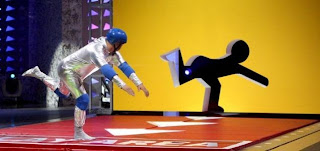For many years, we are familar with using "Void" to make cutout in Revit, whether it is in project or family environment. However, you can never "touch" the curtain wall when it comes to making "void" within the system. Yes, you can edit profile or put empty panel within the wall to achieve certain desired shape, it will never allow the users to cut out part of the curtain mullion or make cut to customed curtain panels.
Ever since version 2012, you can use a "solid" from a family to cut out curtain wall system, this has become a great discovery for me. So now you can do something that looks like this...
 |
| (Image from Hole in the Wall Game Show) |
Once I made all the cut in the curtain wall, I have a yes/no parameter to control the visibility of the solid so that I can "turn off" the solid. As a result, it would appear that the curtain wall is cut out by a void. The good news is you can use the same family to make multiple cuts and it will work on the mullions as well.
So, the question is "Can we put it to a good use in a real project?" Recently, I have a project where we need to incorporate a lot of texts on a metal scrim system, the panels along with the design of the text are supposed to be fabricated with CNC machine. Since we built the metal scrim using curtain wall, using model text on the surface of the wall seems to be a decent solutions. Problem is in-place model text doesn't have the ability to cut out the curtain wall. Then I tried making a face-based family with just the model text and see if Revit will let me use the same trick on curtain panels. To make it more flexible, I even set up the parameter where I can change the text size, the depth as well as the text content.
Surprisingly, I was able to place this face based family hosted to the curtain panel and use cut geometry to cut them out. Because I have an instance parameter where I can edit the text, I can put different content and place it anywhere.
I can also use this trick on concrete panel (made by curtain wall), in this example, I have a parameter where I can control the depth of cutting the concrete.
I hope this might offer another way of dealing with signage or text in Revit, especially if you need them to be part of the curtain wall design.
Stay tuned on the future post as I will show another way of using this soid cut trick on curtain wall.





It is really great discovery, Philip. I can see the potential of typography in architecture, crossover of graphic design and architecture. Thanks for the sharing.
ReplyDeleteI tried this trick in my model but decided not to use it. Now i have deleted the curtain wall but the object I used to cut with is still in the model, but invisible. I cant figure out how to make it visible or how to find it. The problem is that it for some reason it interferes with room objects in the model. Any clue on how to find it?
ReplyDeleteHi Tobias,
ReplyDeleteHave you tried to find the family from the project browser? Go down the "Families" and expand it till you see the family, right click and choose "select all instance". You should be able find it and delete.
Hope this helps.
its not working in revit 2015 with generic family (error when you turno off the solid) , but it works if you use a family from revit 2014.
ReplyDeleteThanks Manuel for reporting this. I tried it in 2015 and it seems Autodesk "fixed" this feature. I did try to set up a new sub-category and assign it to the solid. In the project. you can then go to VG and uncheck the box so the solid would disappear. It is a workaround and it will work in 2015.
ReplyDeletePhilip -- For 2015 workaround, have you tested if your solid disappears for every view template that you uncheck visibility to hide the subcategory? My solid disappears in some view templates like 3D & section, but not floor plan. I thought the problem could be w/ my created templates, so I tested on Revit default "Architectural Plan" under View type filter: Floor, Structural, Area Plans. Solid is not hiding for me in floor plans.
ReplyDeleteManuel.a7 -- thank you for pointing out 2014 rfa works. I could not recreate Phil's steps and it was driving me CRAZY, but I've been testing in R2015. I tried importing 2014 rfa into R2015 and this does not work, but 2014 rfa in R2014 does. I agree Autodesk "fixed" the ability -- ARGH!
Hi Clara,
ReplyDeleteI tested again and was able to verify your issue. If I assign the form with a new sub-category, I can control the visibility in 3D view as well elevations. However, it does not work on floor plan, RCP and sections. Very weird. This is also the case if I bring in a family from 2014 to 2015. Autodesk seems to fix some issues but not all. The way I look at it, they broke this ability rather than fixing it.
Hi! I've used another workaround. I placed the Generic Model Family on a separate workset. You can turn the workset on or off in the VG. The family will disappear but the cutout will be visible in all the views.
ReplyDelete